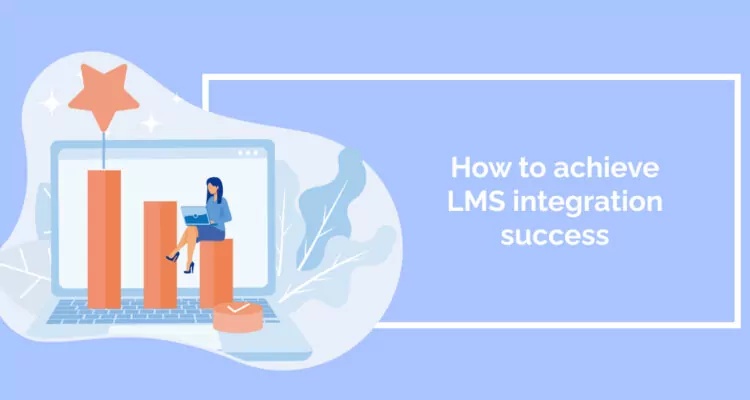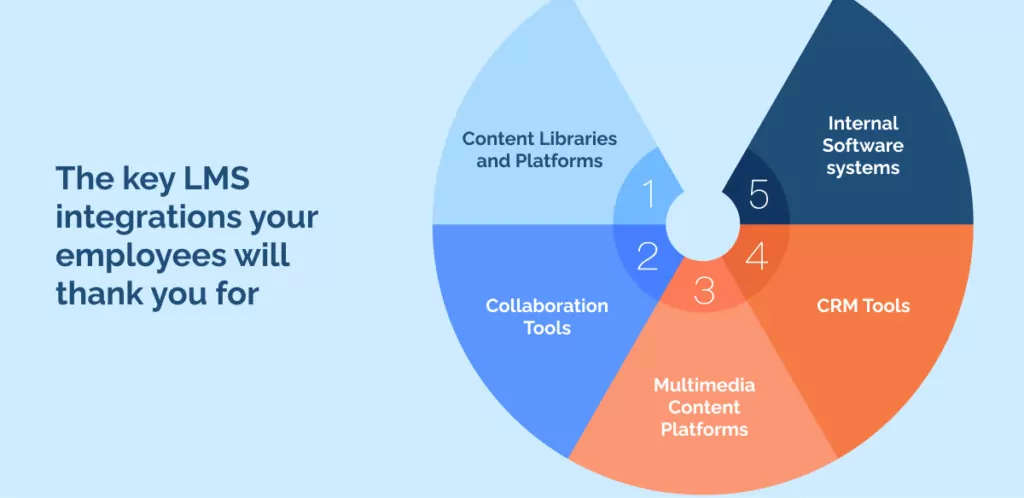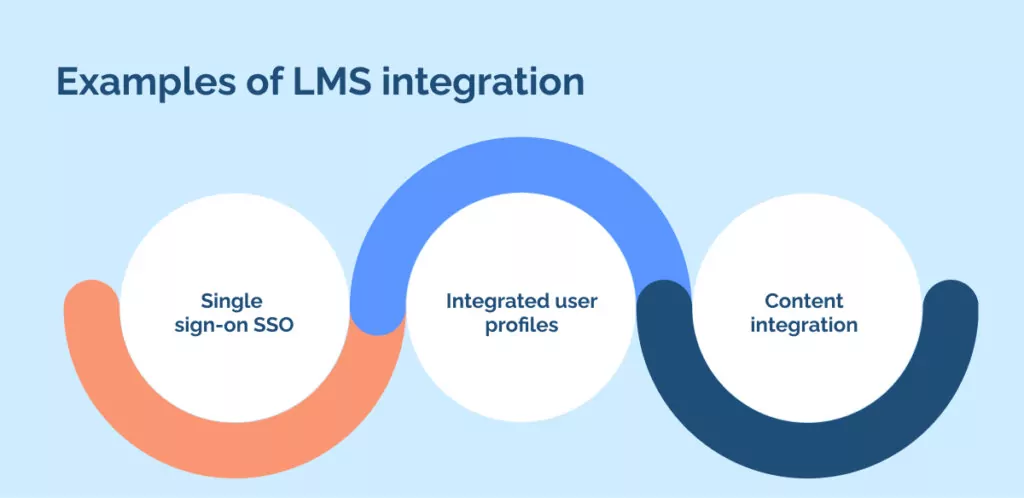
When you help your Learning Management System (LMS) connect with other platforms, you’ve got an LMS integration!
As any CIO knows, the software integration process supports the efficiency and value of those packages. So, companies not integrating their platforms are missing out on a powerful dimension of their software systems.
This article will explain the ins and outs of LMS integration. It will explain:
- What the concept of LMS integration means
- Explain why this is an important tool (and why we need it)
- Offer some of the key LMS integrations that will help your learning activities
- Explain how to integrate your LMS with other systems in three simple phases
By the end, we’ll be clear about LMS integration and how you can support integrated LMS in your company. Seamless integration makes a huge difference to all kinds of training courses, as it helps the learning needs of every employee. So it is well worth understanding!
If you want more information about LMS systems, here is our 2023 learning management systems guide.
But if you’re writing to think about the importance of integrations, let’s dive in.
What is learning management system (LMS) integration?
Achieving LMS integration means connecting your learning platform to various other software.
Connecting your LMS to other software makes sense – for streamlined employee experience, data security, and overall content management. LMS platforms like Rippling,
Absorb and Lessonly all work better when combined with other business tools.
Integrating an LMS with another platform could mean several things. It may involve sharing content, sharing data about users, or sharing data about anything related to learner progress. The core purpose is to communicate better without repetition.
Effective LMS integration supports the core purpose of EduTech today. In 2023, Gartner’s research suggested that user experience was still one of the top challenges for leaders in education. And LMS users know very well that logging in and out of different e-learning software can be one of the most destructive parts of their learning experience.
As such, in today’s connected world, LMS integration is not just a “nice to have” feature. It’s a valuable capability that drives employee training programs more quickly and efficiently.
Why we need LMS integration: three great reasons
LMS integrations are a useful part of effective employee training.
Three of the most important reasons are accessibility, collaboration, and data-driven decision-making:
- Streamlined Accessibility: LMS integrations simplify access to a wealth of learning materials. Users can find many courses and resources within the LMS, eliminating the need for multiple platforms and credentials. This accessibility makes learning more convenient and efficient.
- Enhanced Collaboration: Integrating with collaboration tools like Zoom or Teams promotes real-time interaction and group learning. Learners can join virtual sessions directly from the LMS, improving engagement and facilitating collaborative experiences, which is particularly valuable for remote or hybrid work environments.
- Data-Driven Decision-Making: Integrating with reporting and analytics tools provides valuable insights into training effectiveness. Organizations can assess learner progress, engagement, and course impact, enabling data-driven decisions to optimize training programs and align them with strategic goals.
Your staff may not thank you for these features. However, if you don’t have them, you’ll probably find that your staff are constantly complaining.
The key LMS integrations your employees will thank you for

Do training leaders consciously think about LMS integrations? May not consciously. But as soon as they start devising a new training program, they’ll try connecting all sorts of resources with the LMS. That’s when LMS integration proves itself! After all, modern learning pathways take in material from multiple sources.
So, in this section, we’ll look at the key types of platforms and resources to make your training flow. Content libraries, collaboration tools, multiple platforms, CRM integration, and internal software tools are common priorities for business LMS integration.
Content Libraries and Platforms
Integrating your LMS with content libraries and platforms like LinkedIn Learning, Coursera, or Open edX can provide your users with many learning resources. Access to a vast library of courses and materials allows your employees to expand their knowledge and skills without leaving the LMS environment.
This integration broadens your training options and ensures that your workforce has access to diverse and up-to-date content.
Collaboration Tools
Collaboration tools such as Microsoft Teams, Zoom, and Slack are essential for remote or hybrid work environments. Integrating these tools with your LMS facilitates seamless communication and engagement.
Users can easily join virtual classrooms, webinars, or collaborative learning sessions directly from the LMS. This integration fosters interactive and real-time engagement among learners, instructors, and peers.
Multimedia Content Platforms
In the age of multimedia learning, integrating your LMS with platforms like YouTube or Vimeo is crucial. These integrations enable the seamless incorporation of video content into your courses.
Whether it’s instructional videos, demonstrations, or presentations, multimedia content enhances engagement and understanding. Users can access videos directly within the LMS, providing a cohesive learning experience.
CRM Tools
Integrating your LMS with Customer Relationship Management (CRM) tools like Salesforce can be invaluable, especially if your training extends to customers, partners, or external stakeholders.
This integration allows you to manage customer training records, track interactions, and tailor training programs to meet specific customer needs. It ensures customer training aligns with your CRM efforts, enhancing customer satisfaction and loyalty.
Internal Software systems
Integrating your LMS with internal software systems, such as Enterprise Resource Planning (ERP), Human Capital Management (HCM) platforms, or any HR systems, streamlines processes and data management.
This integration ensures that employee data, including roles, skills, and performance, remains synchronized across systems. It simplifies user management, automates user provisioning, and ensures that training is aligned with organizational objectives. Bringing new employees into the system will be a breeze!
Examples of LMS integration (and why they matter)

We’ve seen how LMS integration can load up your LMS with the full power of your software archipelago. But what will LMS integrations look like for your users, staff, and trainers?
Three of the most obvious ways to see LMS integration in practice are SSO, integrated profiles, and content integration. These simple measures can automatically accelerate the usability of your systems.
Single sign-on SSO
Implementing Single Sign-On allows users to access the LMS and other integrated platforms with single credentials. This eliminates the need for multiple login credentials, reducing friction and simplifying the user experience.
Users can seamlessly move between the LMS and other tools, enhancing convenience and usability.
Integrated user profiles
Integration with other platforms, such as an HR system or talent management software, enables the creation of unified user profiles. User data, including personal information, job roles, and training history, is consistent and up-to-date across all integrated platforms.
Users benefit from accurate and personalized experiences, such as recommended courses based on their roles or skills.
Content integration
Integrating the LMS with content authoring tools, content libraries, or external course providers ensures that a wide range of learning resources is readily accessible within the LMS. Users can explore diverse learning materials without navigating multiple systems, creating a more cohesive and engaging learning experience.
How to integrate learning management systems with other software

This section will look at three key phases for implementing effective integrations: information gathering, technical preparation, integration, and monitoring. Working with your LMS provider will be very helpful in all these steps. Integrating an LMS with multiple applications is a common customer demand – so you can count on the vendor to give you valuable answers.
Phase 1: Information gathering phase
In the initial information-gathering phase of integrating your Learning Management System (LMS) with other software, laying a solid foundation for a successful integration project is imperative. Start by defining clear goals and objectives for the integration program. What specific outcomes are you aiming to achieve? Whether improving user experience, automating processes, or expanding your training resources, a well-defined set of goals will guide your efforts.
Next, choose the appropriate integration method, such as using an Application Programming Interface (API) or middleware platforms, based on your technical capabilities and requirements. Then, identify the platforms you intend to integrate with your LMS, including HR systems, content authoring tools, video conferencing platforms, and more.
Ensure these platforms are compatible with your LMS regarding data formats, security protocols, and technical prerequisites.
The information gathered during this phase forms the basis for the following technical preparation and implementation steps, ultimately leading to a successful integration that aligns with your organizational objectives.
Step 2: Technical preparation
Once you’ve gathered the necessary information and defined your integration goals, the next critical step is the technical preparation phase. Begin by thoroughly assessing compatibility options between your Learning Management System (LMS) and the software systems you aim to integrate. Ensure that data formats, security protocols, and technical requirements align seamlessly for smooth data exchange.
At the same time, determine the most suitable integration methods. That might be through an API, connectors, or middleware platforms, depending on your integration project’s complexity and specific needs. Developing a comprehensive implementation plan is key, including setting priorities for your integration process to ensure a phased and manageable approach. Prioritizing critical integrations can prevent overwhelming your team and end-users.
Lastly, ensure your edTech support team has received adequate training on the chosen integration methods and tools.
This phase sets the stage for the integration work to commence, helping you navigate the technical intricacies confidently and efficiently.
Step 3: Implementation and monitoring
As you progress to the implementation and monitoring phase of integrating your Learning Management System (LMS) with other software, meticulous attention to detail is paramount.
Begin by initiating the integration process, adhering to the earlier technical plans and priorities.
Simultaneously, deploy monitoring mechanisms to track the effectiveness of the integration. Consider using a Digital Adoption Platform (DAP) to assess user engagement, identify pain points, and optimize the user experience. Vigilantly monitor data security throughout the integration to ensure no vulnerabilities or opportunities for data breaches. Implement stringent security protocols and encryption measures to safeguard sensitive information.
Finally, it’s also important to have a well-defined plan to address errors whenever they arise. This could include establishing clear incident response procedures to swiftly resolve issues, minimize disruption, and maintain data integrity. Regularly assess and fine-tune the integration to align with evolving requirements and objectives, ensuring that it continues to deliver the intended benefits to your organization and its users.
Integrate your way to happiness
Your fancy new online training platform won’t count for much if you can’t connect it to other systems. As we’ve seen, LMS integration will help you create courses, deliver online training sessions, and all kinds of knowledge sharing.
These powerful integrations are evidence of the power of digital transformation in the education sector.
As a 2021 case study of Weber University reminds us, digital transformation can radically improve educational outcomes. LMS integrations are one small part of that journey – but they mustn’t be neglected. Moving between multiple platforms is a headache for learners and tedious for data gatherers. A fully integrated educational tech stack works well for everyone.
Over the coming years, the landscape of LMS integrations may develop. After all, McKinsey has reported a trend of edTech companies merging for security – a process that would make integrated LMS systems much easier to achieve.
But for now, integrating online courses with other systems is still a matter that you need to handle strategically. With a better system for organization LMS integrations, you can plan your development programs all the more effectively.
WalkMe Team
WalkMe spearheaded the Digital Adoption Platform (DAP) for associations to use the maximum capacity of their advanced resources. Utilizing man-made consciousness, AI, and context-oriented direction, WalkMe adds a powerful UI layer to raise the computerized proficiency, everything being equal.



